
Glimpse of a Turtle House

This page is based on an article originally printed by The Honolulu Advertiser on August 21, 1994. With the kind permission of Jerry Burris, Editorial Page editor of the Advertiser, the article is presented here in a slightly modified form. We've illustrated the article with images created mostly from Ursula's photography.
Here's how the Advertiser introduced the essay:
When the writer returned to Maui this summer to study Hawaii's endangered green sea turtles, some of her "friends" were missing. She was shocked to see turtles of all ages with tumor disease. She decided others need to know about the turtles and their plight.
I bet you can go through a whole day without giving sea turtles any thought but, for me, they are magical. I am not just talking any sea turtles here, but Hawaiian green sea turtles and not just any Hawaiian green sea turtles, but the population that frequents the turtle house in Honokowai, West Maui.
A "turtle house" is a place where turtles congregate for the purpose of being cleaned by a variety of fishes.
Honokowai Turtle House, 1993 Aikane, Raphael, and Poino talk story at the Turtle House. Aikane is the one being cleaned by the surgeonfishes. Raphael looks on. Poino is partly behind the key mound in the top right corner, obscured by the snappers. 64K JPEG | 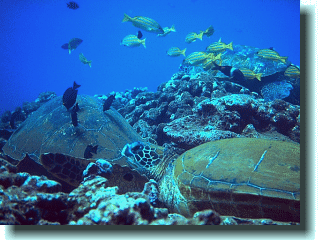
|
Every summer we cross the Pacific (a 13-hour ordeal from Toronto, Canada to Maui) just to visit this turtle house. For eight weeks, we dive twice a day at this same location.
At Honokowai, we have seen sea turtles become increasingly afflicted by fibropapilloma tumors. The incidence of disease has risen from 40% in 1990 to (at time of writing) 73% of our Honokowai regulars. This makes us very sad. To understand why, let me tell you about our experience with these intriguing creatures.
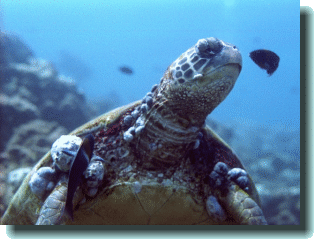
| 1992 Turtle 29 This is one of the worst cases of tumors we saw in 1992. Notice the saddleback wrasses examining the tumors for parasites. Because the bite of these wrasses is painful, heavily tumored turtles don't remain long enough to get much cleaning. 43K JPEG |
Our first dive of the summer is always exciting: Will our friends be there? And they are.
When the sun shines and the water is clear, nothing matches the activity at this turtle house. Perhaps "activity" isn't the best word, since sea turtles just lie on the bottom while surgeonfish clean their shells. The animals we've known the longest watch our approach, realize it's us, then close their eyes and snooze. And for the entire stay, they sit, with front flippers tucked under plastron, eyelids squeezed shut and tranquil, contented looks on their faces.
Raphael & Friends An excellent example of goldring surgeonfish cleaning Raphael's shell. This is the reason the turtles cluster here. 62K JPEG | 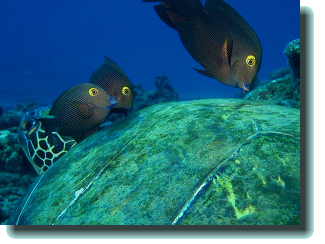
|
Yes, sea turtles have faces. That is how we tell one turtle from another. And their faces are as individual as yours and mine. Brown, leathery scales form patterns and markings unique to the turtle and are fixed for life.
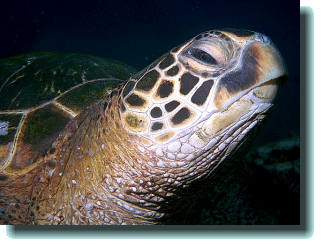
| Profile of Aikane Pictures like this allow us to identify individual turtles. Each profile has a unique pattern, just as each human face has a unique arrangement of features. See the article Identifying Individual Turtles. 67K JPEG |
On a good day, almost a dozen turtles will snooze and hang out with others to talk story at our site. Much like humans, the most active turtles are the youngsters. Adults expend as little energy as possible and can be divided into two camps--the Snoozers, and the Vigilants who tend to rest in the higher regions of a turtle house to get better looks around.
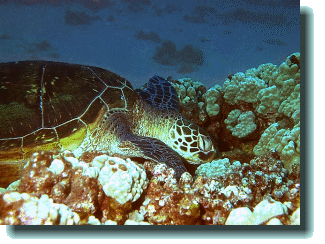
| 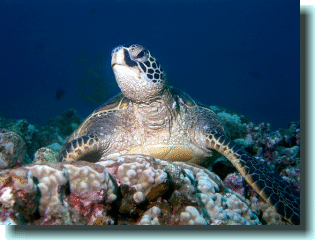
|
Snoozer: Aikane enjoys a beauty nap Of all the Honokowai regulars, none is as laid back as Aikane. She seems to spend more time at the Turtle House than any other turtle, most of it asleep. She's like a cat. 74K JPEG | Vigilant: Howzit keeps an eye on things A typical youngster, active and curious, Howzit likes to perch high up on the Turtle House, the better to see everything that goes on. 48K JPEG |
They clearly have favourite spots. On days when there are lots of turtles, the most coveted location is often where someone is already sitting. Then we witness turtle drama up close and personal.
An incoming turtle turtle sees her spot is already occupied. She hovers over the squatter, body language saying, "I'm gonna land now." She is ignored by the squatter much as we humans will pretend not to notice someone trying to get ahead in heavy traffic. Things get more serious. The turtle now hovers just inches above the squatter.
Sometimes the incoming turtle just gives up. More frequently, the arriving turtle stops hovering and lands directly on the squatter. These situations are most interesting. Either the squatter moves over ("You win"), reluctantly leaves, or we are treated to a most comical sight--a turtle wearing another turtle on its head.
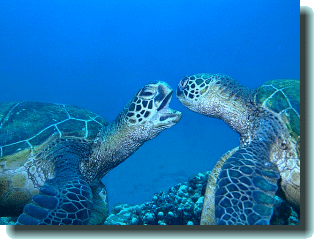
|
Aikane and Goofyfoot have a spat Until the summer of 1995, we rarely noticed turtles displaying their tempers, but this was an exception. This seemed to be a dispute about who could sit where. A couple of leisurely snaps were all that occurred, though. Goofyfoot retreated and everyone went back to sleep. In 1995, we began paying much closer attention to the interaction between turtles. Once we started watching, it became obvious that the Honokowai turtles often went out of their way to interact with one another. Frequently these episodes were aggressive, and we observed much shoving and some snapping. Still, the bites we saw seemed calculated not to do much damage. Goofyfoot, incidentally, is a grump. 57K JPEG |
Amusing as this can be, we have learned that the turtles' lives aren't always this rosy. We've visited this turtle house since 1989 and logged more than 200 hours of direct observation. We've seen the disease there. Fibropapilloma tumors are believed to affect mostly adult turtles, but at Honokowai, even the youngsters have it.
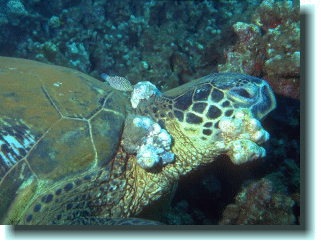
| 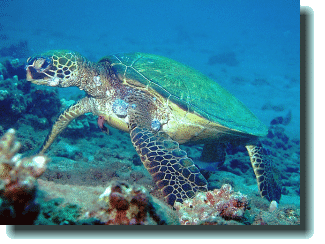
|
Kimo, a severely afflicted adult This is Kimo, a large female adult. A Hawaiian whitespotted toby (C. jactator) is inspecting her tumors for parasites. The bite of the toby, like that of the saddleback wrasse, is painful and often results in the turtle leaving the cleaning station. 59K JPEG | Kamaha'o, a juvenile victim Kamaha'o, formerly called Ghost, one of the smaller and younger Honokowai turtles, assumes a four-point cleaning posture. If the disease follows a normal course in Kamaha'o, the tumors will multiply and increase in size. Eventually, the one at the corner of the mouth will probably enlarge to the point where it interferes with eating. 65K JPEG |
The very first turtle we ever saw was in 1988--a youngster we called Clothahump. Each summer we'd see her. In 1992, she developed suspicious white spots on her eyes and throat. Last summer, we saw her just once. The sight of both her eyes clogged with tumors, tumors on her throat and armpit left both my husband and me sobbing in 20 feet of ocean. (It is hard to cry underwater--your face contorts and water floods your mask.)
Turtles die. I know this. Tiger sharks get them. They get killed by propellers. They get snagged in gill nets and drown. But such deaths are humane compared to fibropapilloma tumors.
The disease often starts in the eyes, and spreads. Particularly gruesome are tumors growing from the corner of the mouth. Large tumors interfere with both breathing and eating. Eventually, blinded and wearing a collar of tumors, the turtle finds swimming difficult. The turtle becomes emaciated and dies.
1991 Turtle 1 First seen in 1991 and logged as 1991 Turtle 1, this turtle shocked us in 1994 by his dramatic deterioration, pictured here. Notice the small triangle at the center of this turtle's profile, and the Y-shaped pattern formed around it. This pattern is how we can identify this individual quickly. If you compare this picture and his 1991 profile carefully, you will see more points of correspondence. 53K JPEG | 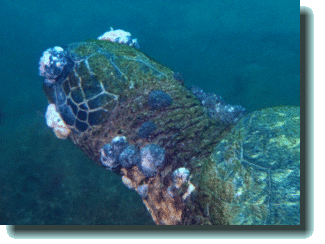
|
But the biggest, most bitter pill for me to swallow is this. Dive at Airport Beach about a mile south, and the young turtles seem fine. Snorkel at Honolua Bay (about 5 miles to the north) and there is no hint of the disease on the youngsters there. But at Honokowai, tumors run rampant.
I no longer welcome the sight of little "recruits" settling into shallow water to make Honokowai their home. The odds are much against them.
Howzit, a 1992 recruit This is a video capture image of Howzit, one of the smallest turtles we saw in 1992. Howzit was not much larger than a dinner plate that summer. Recruits stand out because of both their small size and their unusually clean shells. 63K JPEG | 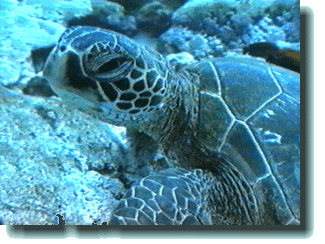
|
My husband and I play things cooler now. We try not to give turtles names any more -- just numbers. Give a turtle a name and you make it a friend. We're sick of seeing our friends develop tumors and we're tired of speculating which of our friends is the turtle skeleton we discovered on our first dive of 1994.
I write because our turtles can't. These creatures need help. Only modest headway has been made against this disease. But mainly I am writing this with the hope that some kid who loves the ocean and its creatures reads this and sees my words as inspiration.
Maybe she'll turn to her mom and say, "When I grow up I want to be a marine biologist. I'm gonna fix tumors."
Study hard, kid.
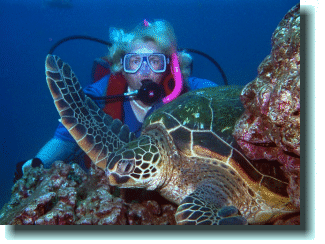
|
Aikane & Friend, 1994 "For the animal shall not be measured by man. In a world older and more complete than ours they move finished and complete, gifted with extensions of the senses we have lost or never attained, living by voices we shall never hear. They are not brethren, they are not underlings; they are other nations, caught with ourselves in the net of life and time, fellow prisoners of the splendour and travail of the earth." --Henry Beston 67K JPEG |
Editor's Note: We have learned a lot about turtles and fibropapilloma since this article was written. For example, we now think that turtles congregate at turtle houses for more complex reasons than just cleaning. We know that at Honokowai, all juveniles will get the disease if they stay in the area. Remarkably, the juvenile Kamaha'o made an astounding recovery--but is the only juvenile we have ever seen regress. Howzit is more typical. In 1995, Howzit was obviously sick. We never saw him after that year. We believe he is dead.